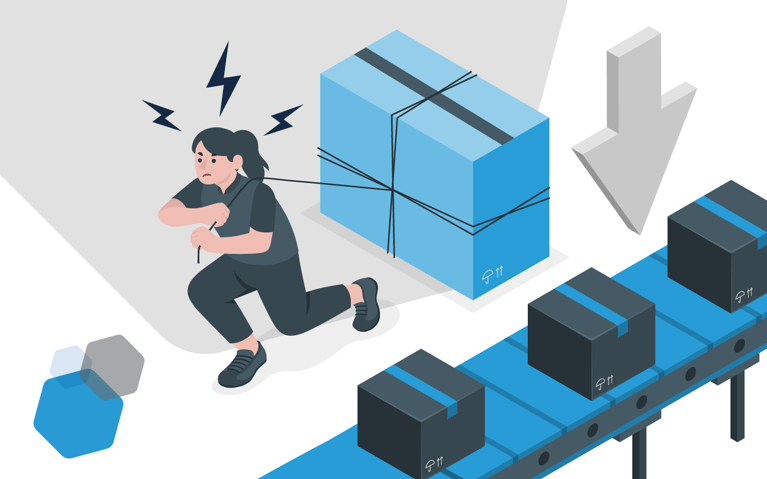On the surface, 4 sounds better than 3, right? When it comes to outsourcing your logistics, however, there’s more than what meets the eye. While similarities exist between a 3PL and 4PL, there are key differences between them. The level of involvement and the scope of their services, as examples. Each represent distinct levels of involvement, and service, in the field of order fulfillment and supply chain management.
In the realm of logistics and supply chain management, the abbreviation "PL" stands for "Party Logistics." The number before "PL" (e.g., 1PL, 2PL, 3PL, 4PL) indicates the level or type of logistics service provider. Thereby, each level of "PL" represents a different degree of involvement and responsibility in the logistics and supply chain management process. So, let's take a closer look at each level of "PL" (1-4) and what makes them unique.
What’s a 1PL?
A first-party logistics (1PL) is a company that manages its own logistics and supply chain operations while also manufacturing and selling its own products. This means that the company handles all its transportation, warehousing, and distribution processes in-house, rather than outsourcing to a third party. Put simply, a 1PL is the company itself that directly handles its logistics and supply chain operations.
When a brand operates as a 1PL, it assumes complete responsibility for and control over its supply chain activities. This can be a daunting task for a single company, with a long list of responsibilities that can include manufacturing, packaging, storing products in their own warehouses, and organizing the transportation of goods to customers or retail locations using their own resources, such as vehicles and facilities.
What’s a 2PL?
A 2PL, or second-party logistics, is an external logistics service provider that primarily deals with the physical transportation of your goods. Unlike a 1PL, which represents the company that produces, sells, or owns the goods and manages its logistics operations internally, a 2PL is an outside company that specializes in the movement of goods from one location to another.
Typically, 2PLs are transportation companies, trucking firms, shipping companies, or freight carriers. They are responsible for the actual transportation of goods, whether it's by road, rail, air, sea, or other means of transportation. Providing various types of transportation services, including shipping, freight forwarding, and logistics solutions related to the movement of cargo, a 2PL is an extension of your brand for transportation requirements.
2PLs play a crucial role in the physical distribution of goods and ensure that product is transported efficiently and safely from point A to point B.
What’s a 3PL?
A 3PL, or third-party logistics, is a third-party service provider that offers a broad range of logistics and supply chain management services to retailers. 3PLs specialize in many aspects of a brand's supply chain and serve as intermediaries between the brand, their suppliers, and their customers.
3PLs are often used by brands to help improve operational efficiency and effectiveness of their supply chain without having to build and manage these capabilities in-house. Outsourcing of these vast logistics functions allows companies to focus on their core competencies while relying on the expertise of 3PLs to manage the complexities of their order fulfillment processes.
Key characteristics of a 3PL:
Transportation: The movement of goods by road, air, sea, or rail. 3PLs will often handle freight shipping, route optimization, and carrier selection.
Warehousing and distribution: Owned or operated warehouses and distribution centers for storage, SKU management, and product distribution.
Inventory management: Management and control of inventory to ensure optimal levels to meet demand without overstocking.
Order fulfillment: 3PLs will pick, pack, ship, and track orders. They’ll also manage returns and handle your brand’s reverse logistics.
Customs clearance and international shipping: For businesses with international customers, 3PLs will handle customs documentation, import/export compliance, and coordinate international shipments.
Supply chain consulting: Some 3PLs provide strategic consulting services to help businesses optimize their supply chain operations, reduce costs, and improve overall efficiency.
Technology solutions: 3PLs will often offer technology tools such as transportation management systems (TMS), warehouse management systems (WMS), or order management systems (OMS) to improve supply chain visibility and control.
Value-added services (VAS): Additional VAS like kitting, labeling, and quality control are offered by a 3PL to enhance the supply chain process.
What’s a 4PL?
A 4PL, or fourth-party Logistics, is a higher-level logistics service provider that plays more of a strategic role in managing and optimizing an entire supply chain than they do a hands-on one. 4PLs serve as a strategic partner that takes a holistic approach to the management of the supply chain, overseeing multiple outsourced logistics providers to optimize efforts. The primary focus of a 4PL is to align the supply chain with business objectives which works toward improving efficiency, resiliency, and performance.
Key characteristics of a 4PL:
Partner Integration: Acting as a supply chain integrator, a 4PL brings together various logistics service providers; 3PLs, carriers, warehousing providers, and other logistics partners. The 4PL serves as the single point of contact for communications, overseeing and managing the activities of different providers to ensure a seamless and efficient fulfillment operation.
Strategic planning: To focus on strategic planning and optimization, 4PLs collaborate with clients to develop supply chain strategies, optimize transit times, and streamline processes to reduce costs. A 4PL will work to align the supply chain with the broader business goals and objectives.
Technology and visibility: 4PLs often leverage advanced technology solutions, such as TMS, WMS, OMS platforms. These tech tools provide real-time data, real-time control, and analytics to enhance brand decision-making.
Performance management: A 4PL partner will measure and monitor the performance of all logistics providers within your supply chain network, holding them accountable for meeting key performance indicators (KPIs) and service level agreements (SLAs). The data collected is used to help continually improve and optimize the supply chain.
Customized solutions: A good 4PL will tailor supply chain services to meet your specific needs and objectives, designing customized supply chain solutions that align with your company's unique industry requirements.
Risk management: Part of the provider's role involves identifying and mitigating supply chain risks by recognizing industry disruptions caused by external, and uncontrollable forces. This attention to detail helps ensure brand continuity and resilience.
Global reach: A 4PL operates worldwide and can help with managing international supply chains, handling customs requirements, organizing cross-border transportation, and dealing with the challenges of cross-border retail.
Key Differences: 3PL vs 4PL
|
3PL Third Party Logistics |
4PL Fourth Party Logistics |
|
|
Scope of services: |
Typically provides specific logistics and supply chain services. Example: transportation, warehousing, distribution, inventory management, and order fulfillment. Handles all operational aspects of the supply chain. |
Offers a strategic range of services. Acts as supply chain integrators, overseeing and managing the entire supply chain, including multiple 3PLs and other logistics partners. |
|
Ownership of assets: |
Owns physical assets like warehouses, trucks, and distribution centers, which they use to provide logistics services. |
Typically does not own physical assets. Instead, they coordinate and manage the assets of various logistics providers, including 3PLs, to create a unified supply chain. |
|
Responsibility: |
Responsible for all logistics functions, operating within the parameters defined by the brand. Both operationally and strategically focused. |
Takes on a broader strategic responsibility. Overseeing the supply chain, they make strategic decisions and help to optimize the overall logistics operation. A more holistic approach to supply chain management. |
|
Coordination: |
Does not typically coordinate other logistics providers. Provides services independently. |
Central point of contact and coordination for various logistics partners within the supply chain. Manages and coordinates the activities of 3PLs and other logistics providers. |
|
Technology and strategy: |
Deploys proprietary technology for specific logistics functions to align with the supply chain strategy and demand. |
Uses various forms of technology platforms centralized by the 4PL; fragmented visibility, data analytics, strategic planning. |
|
Customization: |
Services can be tailored to meet the client's needs. |
Customized solutions to align with the unique requirements and objectives of the brand. |
| Scope of services: | |
| 3PL | 4PL |
|
Typically provides specific logistics and supply chain services. Example: transportation, warehousing, distribution, inventory management, and order fulfillment. Handles all operational aspects of the supply chain. |
Offers a strategic range of services. Acts as supply chain integrators, overseeing and managing the entire supply chain, including multiple 3PLs and other logistics partners. |
| Ownership of assets: | |
| 3PL | 4PL |
|
Owns physical assets like warehouses, trucks, and distribution centers, which they use to provide logistics services. |
Typically does not own physical assets. Instead, they coordinate and manage the assets of various logistics providers, including 3PLs, to create a unified supply chain. |
| Responsibility: | |
| 3PL | 4PL |
|
Responsible for all logistics functions, operating within the parameters defined by the brand. Both operationally and strategically focused. |
Takes on a broader strategic responsibility. Overseeing the supply chain, they make strategic decisions and help to optimize the overall logistics operation. A more holistic approach to supply chain management. |
| Coordination: | |
| 3PL | 4PL |
|
Does not typically coordinate other logistics providers. Provides services independently. |
Central point of contact and coordination for various logistics partners within the supply chain. Manages and coordinates the activities of 3PLs and other logistics providers. |
| Technology and strategy: | |
| 3PL | 4PL |
|
Deploys proprietary technology for specific logistics functions to align with the supply chain strategy and demand. |
Uses various forms of technology platforms centralized by the 4PL; fragmented visibility, data analytics, strategic planning. |
| Customization: | |
| 3PL | 4PL |
|
Services can be tailored to meet the client's needs. |
Customized solutions to align with the unique requirements and objectives of the brand. |
Choosing the right solution for your brand
The choice between a 3PL (Third-Party Logistics) and a 4PL (Fourth-Party Logistics) depends entirely on the unique needs, goals, and situation of your brand. Neither one is inherently superior to the other; it's simply a matter of selecting the logistics service provider that is the best fit for your specific business.
Ultimately, the decision should be based on a thorough analysis of your company's specific supply chain requirements as well as the level of expertise and operational dedication required to deliver on your brand promises. It's also possible to work with both types of providers in a complementary manner. For example, you could use a 3PL for specific functions and a 4PL to oversee and optimize the overall supply chain strategy. The key to successful ecommerce operations is to align the logistics service provider with your business goals and supply chain requirements.
If you're unsure whether to choose a 3PL or 4PL for your business, reach out to our Cart.com fulfillment experts who can guide your brand's journey.
Subscribe to our emails for the latest industry insights!
By entering your email, you agree to receive marketing emails from Cart.com






